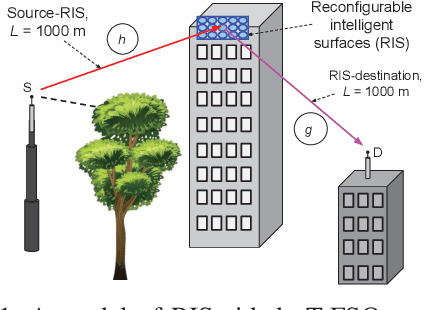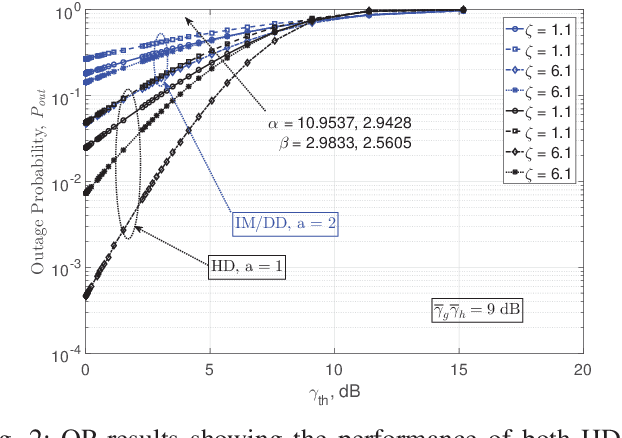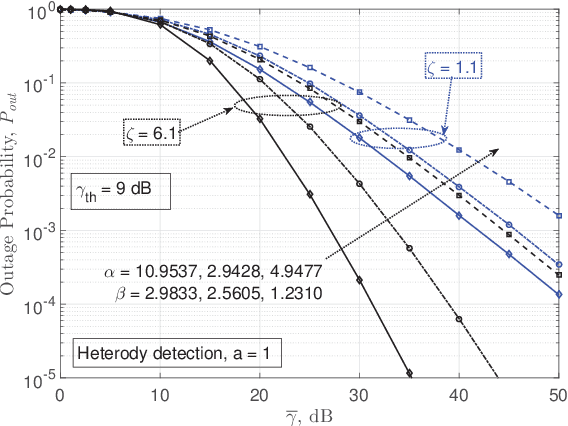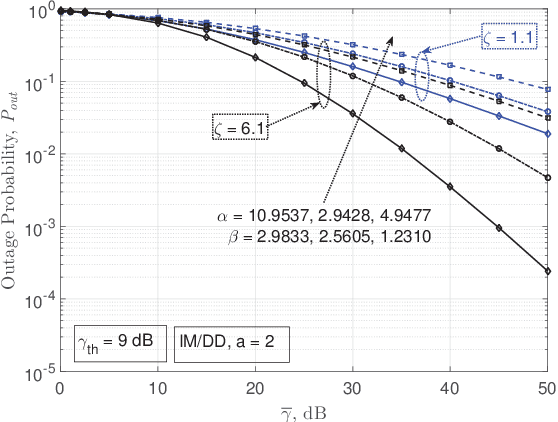Alain R. Ndjiongue
Power Cable Radiation: A Novel Approach to Underground Mining Connectivity
Oct 10, 2025Abstract:This letter investigates contactless power line communications (CPLC) for underground mining by modeling power wires as long-wire antennas. A system-level framework is developed, comprising a cascade of RF and power line channels. The model accounts for multipath propagation, frequency-dependent attenuation, and Rician fading. Simulations from 1-20 GHz reveal that the length of the wire significantly affects radiation, directivity, and input impedance. The findings show that CPLC transmits electromagnetic waves without direct electrical contact, offering a robust, cost-effective solution that enhances mobility, reduces maintenance, and ensures compatibility with existing mining power infrastructure.
Underwater Multi-Wavelength Optical Links With Blue Targets and Constraints: Opportunities and Challenges
Apr 21, 2025Abstract:Underwater optical wireless technologies offer multiple advantages over the acoustic technology. Acoustic signals, for instance, are susceptible to noise from marine sources due to marine life and human activities. This is not the case with optical signals. However, absorption and scattering significantly attenuate optical signals. This limits the communication range and requires higher transmission power or more sensitive receivers to detect transmitted light. Therefore, it is necessary to design underwater optical systems with a higher transmission rate and reduced attenuation. To this end, we introduce a framework for designing optical signaling constellations employing multi-wavelength light sources to account for the transmission distance and achievable rate. In particular, we redefine the color-shift keying (CSK) constraint region to target blue light and adapt to marine environments. We discuss an example of 4-point underwater CSK. The corresponding analytical results demonstrate the trade-offs between the symbol error probability, achievable rate, and transmission range of the proposed scheme.
Maximal Transmission Rate in Omni-DRIS-Assisted Indoor Visible Light Communication Systems
Oct 17, 2024



Abstract:Given the importance of reconfigurable intelligent surfaces (RISs) in next-generation mobile systems, several RIS variants have been proposed in recent years. Omni-digital-RIS (omni-DRIS) is one of the newly introduced variants of optical RIS that can successfully be driven by bit sequences to control lights emerging from simultaneous reflection and refraction processes, impacting both the achievable rate and the required number of omni-DRIS elements. In this paper, we analyze the effects of omni-DRIS-assisted transmission environment parameters to maximize the achievable rate and highlight the corresponding number of omni-DRIS elements. Furthermore, we show that the number of omni-DRIS elements that yields the highest achievable rate largely depends on the number of bits per omni-DRIS control sequence. On the other hand, this rate is determined by the remaining parameters of the transmission system and environmental factors, which include the total transmit power, transmission bandwidth, number of transmitters and users, and the channel DC gain.
Liquid Crystal-Based RIS for VLC Transmitters: Performance Analysis, Challenges, and Opportunities
Aug 18, 2023



Abstract:This article presents a novel approach of using reconfigurable intelligent surfaces (RISs) in the transmitter of indoor visible light communication (VLC) systems to enhance data rate uniformity and maintain adequate illumination. In this approach, a liquid crystal (LC)-based RIS is placed in front of the LED arrays of the transmitter to form an LC-based RIS-enabled VLC transmitter. This RIS-enabled transmitter is able to perform new functions such as transmit light steering and amplification and demonstrates very high data rate and illumination performance when compared with traditional VLC transmitters with circular and distributed LED arrays and the more recent angle diversity transmitter. Simulation results reveal the strong potential of LC-based RIS-aided transmitters in satisfying the joint illumination and communication needs of indoor VLC systems and positions VLC as a critical essential block for next generation communication networks. Several challenging and exciting issues related to the realization of such transmitters are discussed.
RIS-Assisted Visible Light Communication Systems: A Tutorial
Apr 14, 2022



Abstract:Recent development of the fifth-generation (5G) of cellular networks has led to their deployment worldwide. As part of the implementation, one of the challenges that must be addressed is the skip-zone problem, which occurs when objects obstruct the transmission of signals. A signal obstruction can significantly reduce the signal-to-noise ratio in radio frequency (RF) and indoor visible light communications (VLC) systems, whereas the obstruction can completely disrupt data transmission in free-space optical (FSO) systems. Therefore, the skip-zone dilemma must be resolved to ensure the efficient operation of 5G and beyond networks. In recent years, reconfigurable intelligent surfaces (RISs) that are more efficient than relays have become widely accepted as a method of mitigating skip-zones and providing reconfigurable radio environments. However, there have been limited studies on RISs for optical wireless communication (OWC) systems. This paper aims to provide a comprehensive tutorial on indoor VLC systems utilizing RISs technology. The article discusses the basics of VLC and RISs and reintroduces RISs for OWC systems, focusing on RIS-assisted indoor VLC systems. We also provide a comprehensive overview of optical RISs and examine the differences between optical RISs, RF-RISs, and optical relays. Furthermore, we discuss in detail how RISs can be used to overcome line-of-sight blockages and device orientation issue in VLC systems while revealing key challenges such as RIS element orientation design, RIS elements to access point/user assignment design, and RIS array positioning design problems that need to be studied. Moreover, we discuss and propose several research problems on integrating optical RISs with other emerging technologies and highlight other important research directions for RIS-assisted VLC systems.
Double-Sided Beamforming in OWC Systems Using Omni-Digital Reconfigurable Intelligent Surfaces
Mar 08, 2022



Abstract:In this paper, we introduce a variant of reconfigurable intelligent surfaces (RISs) called omni-digital-RISs (DRISs), which allow multiple physical processes, with application to optical wireless communications systems. The proposed omni-DRIS contains both reflectors and refractive elements, as well as elements that perform both simultaneously. We describe and explain the concept of omni-DRIS, suggest and analyze an omni-DRIS coding structure, discuss metamaterials to be used, and provide a design example. Furthermore, we demonstrate that the achievable rate of an omni-DRIS system depends on the number of omni-DRIS elements, bits per phase shift, and the number of unused elements. In addition, we show that the achievable rate upper bound is related to the number of omni-DRIS elements, and conclude by discussing future research directions.
Digital RIS : The Future of Digital Beam Management in RIS-Assisted OWC Systems
Dec 18, 2021



Abstract:Reconfigurable intelligent surfaces (RIS) have been recently introduced to optical wireless communication (OWC) networks to resolve skip areas and improve the signal-to-noise ratio at the user's end. In OWC networks, RIS are based on mirrors or metasurfaces. Metasurfaces have evolved significantly over the last few years. As a result, coding, digital, programmable, and information metamaterials have been developed. The advantage of these materials is that they can enable digital signal processing (DSP) techniques. For the first time, this paper proposes the use of digital RIS (DRIS) in OWC systems. We discuss the concept of DRIS and the application of DSP methods to the physical material. In addition, we examine metamaterials for optical DRIS with liquid crystals serving as the front row material. Finally, we present a design example and discuss future research directions.
Design of a Power Amplifying-RIS for Free-Space Optical Communication Systems
Apr 08, 2021



Abstract:The steering dynamics of re-configurable intelligent surfaces (RIS) have hoisted them to the front row of technologies that can be exploited to solve skip-zones in wireless communication systems. They can enable a programmable wireless environment, turning it into a partially deterministic space that plays an active role in determining how wireless signals propagate. However, RIS-based communication systems' practical implementation may face challenges such as noise generated by the RIS structure. Besides, the transmitted signal may face a double-fading effect over the two portions of the channel. This article tackles this double-fading problem in near-terrestrial free-space optical (nT-FSO) communication systems using a RIS module based upon liquid-crystal (LC) on silicon (LCoS). A doped LC layer can directly amplify a light when placed in an external field. Leveraging on this capacity of a doped LC, we mitigate the double-attenuation faced by the transmitted signal. We first revisit the nT-FSO power loss scenario, then discuss the direct-light amplification, and consider the system performance. Results show that at 51 degrees of the incoming light incidence angle, the proposed LCoS design has minimal RIS depth, implying less LC's material. The performance results show that the number of bit per unit bandwidth is upper-bounded and grows with the ratio of the sub-links distances. Finally, we present and discuss open issues to enable new research opportunities towards the use of RIS and amplifying-RIS in nT-FSO systems.
Performance Analysis of RIS-Based nT-FSO Link Over G-G Turbulence With Pointing Errors
Feb 06, 2021



Abstract:One of the main problems faced by communication systems is the presence of skip-zones in the targeted areas. With the deployment of the fifth-generation mobile network, solutions are proposed to solve the signal loss due to obstruction by buildings, mountains, and atmospheric or weather conditions. Among these solutions, re-configurable intelligent surfaces (RIS), which are newly proposed modules, may be exploited to reflect the incident signal in the direction of dead zones, increase communication coverage, and make the channel smarter and controllable. In this paper, we tackle the skip-zone problem in near-terrestrial free-space optical (nT-FSO) systems using RIS. We carry out a performance analysis of RIS-aided nT-FSO links affected by turbulence and pointing errors, for both heterodyne detection (HD) and intensity modulation-direct detection (IM/DD) techniques. Turbulence is modeled using the Gamma-Gamma (G-G) distribution. We analyze the model and provide exact closed-form expressions of the probability density function, cumulative distribution function, and moment generating function of the end-to-end signal-to-noise ratio, $\gamma$. Capitalizing on these statistics, we evaluate the system performance through the outage probability, $ P_{out} $, ergodic channel capacity, $\overline{C}$, and average bit-error-rate, $\overline{P}_b$, for selected binary modulation schemes. Numerical results obtained for different turbulence levels and pointing errors confirm that the HD technique outperforms IM/DD even in RIS-aided nT-FSO systems. These results also show that using a blue color offers better channel capacity and communication performance compared to red and green colors.
Re-configurable Intelligent Surface-based VLC Receivers Using Tunable Liquid-crystals: The Concept
Jan 07, 2021



Abstract:Visible light communication (VLC) enables access to huge unlicensed bandwidth, a higher security level, and no radio frequency interference. With these advantages, VLC emerges as a complementary solution to radio frequency communications. VLC systems have primarily been designed for indoor scenarios with typical transmission distances between 2 and 5 m. Different designs would be required for larger distances. This paper proposes for the first time the use of a liquid crystal (LC)-based re-configurable intelligent surface (RIS) on improving the VLC signal detection and transmission range. An LC-based RIS presents multiple advantages, including the tunability of its photo-refractive parameters. Another advantage is its light amplification capabilities when under the influence of an externally applied field. In this paper, we analyze an LC-based RIS structure to amplify the detected light and improve the VLC signal detection and transmission range. Results show that mixing LC with 4 to 8 wt\% concentration of a dye such as the terthiophene (3T-2MB) improves the VLC transmission range of about 0.20 to 1.08 m. This improvement can reach 6.56 m if we combine 8 wt\% concentration of 3T-2MB and 0.1 wt\% concentration of trinitrofluorenone.
 Add to Chrome
Add to Chrome Add to Firefox
Add to Firefox Add to Edge
Add to Edge